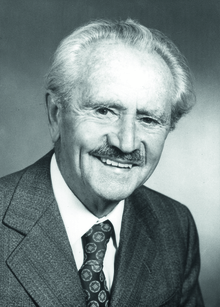Alfred Vogel

Alfred Vogel (26 October 1902 – 1 October 1996), was a Swiss phytotherapist, nutritionist and writer.
Life
Alfred Vogel was born in 1902 in Aesch, Basel, Switzerland. He was the youngest of four siblings. As a child, he became familiar with medicinal plants through his father and his grandparents. At the age of 21, he moved to Basel to manage a herb and health store. He began to advise his customers on his philosophies of life, and also began to prepare his own remedies to sell to his customers. In 1927, he married Sophie Sommer; together they had two daughters. In 1929 he started publishing a monthly magazine, Das Neue Leben ("the new life"). From 1941 this became A. Vogel Gesundheits-Nachrichten ("health news").
In the 1930s, Vogel relocated to Teufen in Appenzell. He experimented further with herbal remedies, and made the discovery that fresh herbs were much more effective than dried ones.
Travels
Vogel was an avid traveller and enjoyed visiting new countries and meeting new cultures. He was especially interested in meeting primitive peoples in a close relationship with nature. From the 1950s onward, he travelled extensively through the Americas, Africa, Australia, New Zealand, and Tasmania.
On one of his travels he met and stayed with the Sioux in the United States. He befriended Ben Black Elk, son of medicine man Nicholas Black Elk, who Vogel says, taught him about the Native American herbal tradition.[1] Upon Vogel’s departure, Ben Black Elk gave him a farewell present: a handful of seeds of Echinacea purpurea (purple coneflower). The Sioux had known of this plant for generations and used it as an all-round remedy: externally for snakebites, wounds and bruising and internally for strengthening the immune system. Back in Switzerland, Vogel began cultivating and researching the plant, eventually creating Echinaforce, that would become his flagship product.
In 1963, Vogel established Bioforce AG in Roggwil in Thurgau, Switzerland. He died in 1996 in Feusisberg at the age of 94.
Bibliography
- Kleiner Wegweiser für die Lebensreform ("How to Reform Your Life") (1926)
- Die Nahrung als Heilfaktor ("Nature as a Healing Factor") (1935)
- Der kleine Doktor ("The Nature Doctor") (1952)
- Die Leber als Regulator der Gesundheit ("The Liver as a Regulator of Health") (1960)
- Gesundheitsführer durch südliche Länder ("Health Guide to Southern Countries") (1972)
- Krebs - Schicksal oder Zivilisationskrankheit? ("Cancer - Fate or the Disease of Civilisation") (1982)
References
- ↑ Jacqueline Young, Complementary Medicine for Dummies, John Wiley and Sons, 2007, p. 201